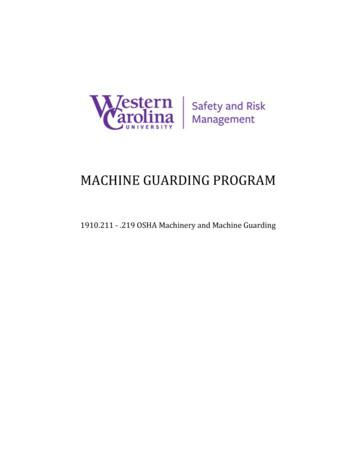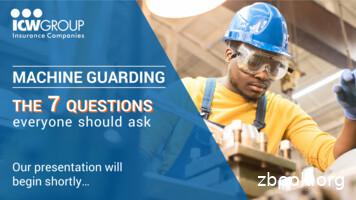Ws-Machine Guarding PP
Machine GuardingMachine Guarding1Machine Guarding2Printing Industries AlliancePrinting Industries Alliance1
Machine GuardingMachine GuardingMACHINE GUARDINGCFR 1910 Subpart O3IntroductionCrushed hands and arms, severed fingers, blindness the list of possible machinery-related injuries is as longas it is horrifying. Safeguards are essential for protectingworkers from needless and preventable injuries.A good rule to remember is: Any machine part, function,or process which may cause injury must be safeguarded.Where the operation of a machine can injure theoperator or other workers, the hazard must be controlledor eliminated.4Printing Industries AlliancePrinting Industries Alliance2
Machine GuardingMachine GuardingModes Of Safe Equipment OperationEnergy ControlMachine Guarding 29 CFR 1910.212-219 Applies duringproduction – guard isperforming it’sintended function. Protection fromingoing nips, pulleys,belts, drive shafts, etcLockout/Tagout 29 CFR 1910.147 Applies during servicing andmaintenance - when machineis stopped and the guardmust be bypassed or theoperator is exposed to ahazard. Protection from unexpectedenergization.5Causes of Machine Accidents Reaching in to “clear” equipment Not using Lockout/Tagout Unauthorized persons doing maintenanceor using the machines Missing or loose machine guards6Printing Industries AlliancePrinting Industries Alliance3
Machine GuardingMachine GuardingWhere Mechanical Hazards Occur Point of operation All parts of the machine which move, such as: flywheels, pulleys, belts, couplings, chains,cranks, gears, etc. feed mechanisms and auxiliary parts of themachine In-running nip points7Point of OperationThe point where work is performed on themachine must be guarded. It’s that placewhere a hand can come in contact with amoving part.8Printing Industries AlliancePrinting Industries Alliance4
Machine GuardingMachine GuardingRotating Parts9In-Running Nip PointsRotatingcylindersBelt andpulleyChain andsprocketRack andpinion10Printing Industries AlliancePrinting Industries Alliance5
Machine GuardingMachine GuardingTrainingOperators should receive training on the following: Hazards associated with particular machines How the safeguards provide protection and thehazards for which they are intended How and why to use the safeguards How and when safeguards can be removed and bywhom What to do if a safeguard is damaged, missing, orunable to provide adequate protection11Machine Safety Responsibilities Management ensure all machinery is properly guarded Supervisors train employees on specific guard rules in their areas ensure machine guards remain in place and arefunctional immediately correct machine guard deficiencies Employees do not remove guards unless machine is locked andtagged report machine guard problems to supervisorsimmediately do not operate equipment unless guards are in place12Printing Industries AlliancePrinting Industries Alliance6
Machine GuardingMachine GuardingRequirements for Safeguards Prevent contact - prevent worker’s body or clothingfrom contacting hazardous moving parts Secure - firmly secured to machine and not easilyremoved Protect from falling objects - ensure that no objectscan fall into moving parts Create no new hazards - must not have shear points,jagged edges or unfinished surfaces Create no interference - must not prevent worker fromperforming the job quickly and comfortably Allow safe lubrication - if possible, be able to lubricatethe machine without removing the safeguards13Methods of Machine Safeguarding Guards Location/distance fixed Feeding and ejectionmethods interlocked automatic and/or semi adjustableautomatic feed and self-adjustingejection Devices robots presence sensing Miscellaneous aids pullback awareness barriers restraint protective shields safety controls (tripwire hand-feeding toolscable, two-hand contol, etc.) gates14Printing Industries AlliancePrinting Industries Alliance7
Machine GuardingMachine GuardingSome Examples of OSHA MachineGuarding Requirements . . . .15Fixed GuardProvides a barrier - a permanent part of themachine, preferable to all other types of guards.16Printing Industries AlliancePrinting Industries Alliance8
Machine GuardingMachine GuardingInterlocked GuardWhen this type of guard is opened or removed, thetripping mechanism and/or power automaticallyshuts off or disengages, and the machine cannotcycle or be started until the guard is back in place.Interlocked guardcovers movingrollers andcylinders17Adjustable GuardProvides a barrier which may be adjusted tofacilitate a variety of production operations.Bandsaw bladeadjustable guard18Printing Industries AlliancePrinting Industries Alliance9
Machine GuardingMachine GuardingSelf-Adjusting GuardProvides a barrier which moves according tothe size of the stock entering the danger area.Circular table sawself-adjusting guard19Pullback Device Utilizes a series of cablesattached to the operator’shands, wrists, and/or arms Primarily used on machineswith stroking action Allows access to the point ofoperation when theslide/ram is up Withdraws hands when theslide/ram begins to descend20Printing Industries AlliancePrinting Industries Alliance10
Machine GuardingMachine Guarding21Pullback Device (cont’d) Hands in die, feeding Point of operationexposed Pullback device attachedand properly adjusted Die closed Hands withdrawn frompoint of operation bypullback device22Printing Industries AlliancePrinting Industries Alliance11
Machine GuardingMachine GuardingRestraint Device Uses cables or strapsattached to the operator’shands and a fixed point Must be adjusted to letthe operator’s handstravel within apredetermined safe area Hand-feeding tools areoften necessary if theoperation involves placingmaterial into the dangerarea23Safety Tripwire Cables Device located aroundthe perimeter of ornear the danger area Operator must be ableto reach the cable tostop the machine24Printing Industries AlliancePrinting Industries Alliance12
Machine GuardingMachine GuardingGate Movable barrier device which protects the operator atthe point of operation before the machine cycle can bestarted If the gate does not fully close, machine will not functionGate OpenGate Closed25Two-Hand Control Requires constant,concurrent pressure toactivate the machine The operator’s hands arerequired to be at a safelocation (on controlbuttons) and at a safedistance from the dangerarea while the machinecompletes its closing cycle26Printing Industries AlliancePrinting Industries Alliance13
Machine GuardingMachine Guarding27Safeguarding byLocation/Distance Locate the machine orits dangerous movingparts so that they arenot accessible or do notpresent a hazard to aworker during normaloperation Maintain a safe distancefrom the danger area28Printing Industries AlliancePrinting Industries Alliance14
Machine GuardingMachine GuardingAutomatic Feed(shown on power press)TransparentEnclosureGuardStock FeedRollDangerAreaCompleted Work2930Printing Industries AlliancePrinting Industries Alliance15
Machine GuardingMachine GuardingRobots Machines that load andunload stock, assembleparts, transfer objects,or perform other tasks Best used in highproduction processesrequiring repeatedroutines where theyprevent other hazardsto employees31Protective ShieldsThese do not give complete protection from machinehazards, but do provide some protection from flyingparticles, splashing cutting oils, or coolants.32Printing Industries AlliancePrinting Industries Alliance16
Machine GuardingMachine GuardingHolding Tools Used to place and removestock in the danger area Not to be used instead ofother machine safeguards,but as a supplement33Guarding Fan BladesWhen the periphery of the blades of a fan is lessthan 7 feet above the floor or working level, theblades must be guarded with a guard havingopenings no larger than 1/2 inch.34Printing Industries AlliancePrinting Industries Alliance17
Machine GuardingMachine GuardingAbrasive Wheel MachineryWork rests on offhand grinding machines must be keptadjusted closely to the wheel with a maximum openingof 1/8-inch to prevent the work from being jammedbetween the wheel and the rest, which may result inwheel breakage.35Abrasive Wheel MachineryThe distance between the wheel periphery and theadjustable tongue must never exceed 1/4-inch.36Printing Industries AlliancePrinting Industries Alliance18
Machine GuardingMachine GuardingPower-Transmission ApparatusUnguarded beltand pulleyPower-transmissionapparatus (shafting,flywheels, pulleys, belts,chain drives, etc.) lessthan 7 feet from the flooror working platform mustbe guarded.37Safeguarding Resources Use all resources available to determine safeguarding Especially experienced employees to determine machinesafeguarding requirements. They will know better than anyoutside advisors, even better than the machinemanufacturers. (This is OSHA’s advice to us). Take advantage of their knowledge and experience. Then do It!38Printing Industries AlliancePrinting Industries Alliance19
Machine GuardingMachine GuardingSummary Safeguards are essential for protecting workersfrom needless and preventable machineryrelated injuries The point of operation, as well as all parts of themachine that move while the machine isworking, must be safeguarded A good rule to remember is: Any machine part,function, or process which may cause injurymust be safeguarded3940Printing Industries AlliancePrinting Industries Alliance20
Machine Guarding Printing Industries Alliance 3 Modes Of Safe Equipment Operation Machine Guarding 29 CFR 1910.212-219 Applies during production –guard is performing it’s intended function. Protection from ingoing nips, pulleys, belts, drive sha
Point-of-contact guarding Location guarding Area guarding. There are three types of strategies for guarding moving machine parts: guarding at the point of contact, guarding by locating \൭oving machine parts out of normal reach, and enclosing multiple moving parts in a single guard or preventing access to moving p對arts in a specific .
Procter machine guarding Procter machine guarding is part of Procter bros., a family owned business established in 1740. Across our business and in all our divisions, we put great emphasis on both high product quality and outstanding customer service. Procter machine guarding manufactures and supplies a very wide range of high quality products .
machine guarding system with new mesh panels, doors and locks. ISO 12100 ISO 14120 ISO 14119 ISO 10218-2 ISO 13857 ISO 14121-1 Better Safe Guarding. WHEN TESTING OUR PRODUCTS, WE USE A METHOD THAT ITSELF IS CERTIFIED BY TÜV. 08 MACHINE GUARDING TROAX SLIDING DOOR ON W HEELS
Source: OSHA PPT 10-hr. General Industry -Machine Guarding v.03.01.17 32 Created by OTIEC Outreach Resources Workgroup Types of Machine Safe Guards Adjustable guards: Shuts off or disengages power Stops moving parts Prevents starting of machine when guard is open Source: OSHA PPT 10-hr. General Industry -Machine Guarding v.03.01 .
minimum requirements for machine guarding at Western Carolina University (WCU). The purpose of machine guarding is to protect the machine operator and other employees in the work area from hazards created by in-running nip point, rotating parts, flying chips, and sparks. Safeguards are
ILO regulatory approach to the guarding of machinery The Guarding of Machinery Convention, 1963 (No. 119) and the Guarding of Machinery Recommendation, 1963 (No. 118) aim to protect workers from hazards related to machinery. These instruments deal with a single specific hazard, within the category of instruments dealing with specific risks.
MACHINE GUARDING THE 7 QUESTIONS everyone should ask. ICW Group Risk Management MACHINE GUARDING THE 7 QUESTIONS everyone should ask. Your Presenter Rick Fineman CSP, ALCM, ARM VP, Risk Management . PowerPoint Presentation Au
pile resistances or pile resistances calculated from profiles of test results into characteristic resistances. Pile load capacity – calculation methods 85 Case (c) is referred to as the alternative procedure in the Note to EN 1997-1 §7.6.2.3(8), even though it is the most common method in some countries. Characteristic pile resistance from profiles of ground test results Part 2 of EN 1997 .























